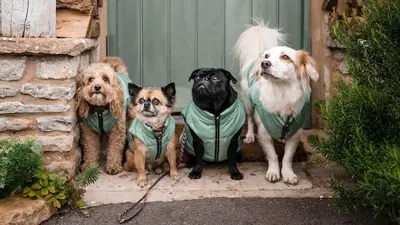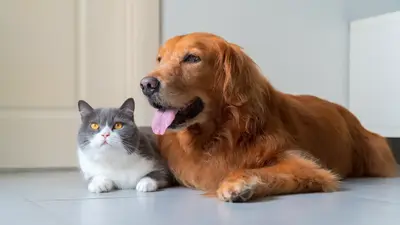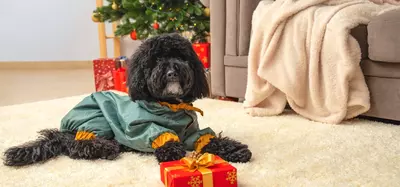Dog Breeds That Don't Shed
- 05 Apr 2023
- 4m read

Love dogs but don't love sneezing? We empathise. Many allergies to dogs are actually a reaction to their hair and dander, so sharing a home with a shedding pooch is a no-go.
But don't give up on the idea of bringing a furry family member into your life. There are many low-shedding dog breeds which are less likely to get all up in your nose.
Some pet parents really don't mind a bit of fluff. If you don't have an allergy (or a posh sofa) you may simply shrug and get on with the daily vacuuming. However, if you suffer from a dog-hair intolerance, that's not an option. It also could be that you have a job where you have to look super-smart or you work in an environment where stray hairs are a no-no.
What Does a Hypoallergenic Dog Mean?
Hypoallergenic is a term that refers to things which are believed to be less likely to cause allergy symptoms. For example, you may have seen bedding described as hypoallergenic and this is often purchased to prevent the likelihood of dust mites, which trigger allergic reactions.
Truth be told, no dog is 100% hypoallergenic.
Many people believe that dogs with certain types of non-shedding fur are hypoallergenic, but this isn’t technically the case. This is because it is not just fur which can trigger allergy symptoms, but also dander (dead skin cells) and saliva, we all know how much some pooches like a kiss.
Having said that, there are certain breeds that are considered to be better for allergy sufferers because they are less likely to shed large amounts of fur. Poodles are a popular option, but there’s many to choose from in our list below.
Small Dogs That Don’t Shed
Some of the most popular small but mighty non-shedders include:
Basenji
A less-well known breed, the Basenji is a fabulous family dog, known to make an endearing, yodelling sound. Not only does the Basenji not moult, but this ultra-clean dog will groom itself, like a cat.
Bedlington Terrier
The adorably lamb-like, woolly coat of the Bedlington Terrier stays on the dog, not on the rug. And generally speaking, most terriers have wiry coats and are a low-shedding group.
Bichon Frise
With a name that translates to "fluffy white dog", it's hard to imagine that the snowy-coated Bichon Frise doesn't shed. But cuddle them all you like, there's no hair coming off here.
Brussels Griffon
Small in stature but big in personality, Brussels Griffons are highly energetic and intelligent. A pint sized Einstein if you will. Plus, they have a beard even Dumbledore would be impressed by.
Maltese
A tiny Ancient-Greek breed – is appealing, popular and kind to allergy sufferers. These toy dogs have silky fur and sweet natures. They get on well with other pets, so you could always team one with a hairless cat to create the perfect, shed-free duo.
Miniature Schnauzer
This adorable breed also keeps hair-loss on the down-low, as well as being a playful, cheerful little friend.
Shih-Tzu
The same also goes for the adorable Shih-Tzu which doesn't moult much but does need regular and thorough grooming. With a pom-pom tail like theirs, it’s hard not to think you have your own personal cheerleader.
Yorkshire Terrier
Have you ever noticed how a Yorkshire Terrier's long, fine fur is closer to human hair than a typical dog coat? Unlike lots of long-haired pet parents, the Yorkie won't shed strands all over the house. But they will demand a fair bit of brushing.
Medium Dogs That Don’t Shed
Not too big, not too small. There are plenty of medium-sized breeds that are known for their low-shedding characteristics:
Irish Water Spaniel
The Irish Water Spaniel is a low-moulting breed with a curly coat that repels water. These are upbeat pups who love playing, children and, of course, swimming.
Portuguese Water Dog
Similar to the Irish Water Spaniel, Portuguese Water Dogs have a signature curly coat known to aid their love of swimming. Can't picture one? Google "Barack Obama's dogs" and you'll soon get some super-sweet pics of this presidential pooch, chosen because of family allergies.
Big Dogs That Don’t Shed
Allergy-friendly dogs come in all shapes and sizes, here are some of our favourite bigger breeds that won’t have you reaching for the antihistamines.
Afghan Hound
Amazingly, the elegant Afghan Hound doesn't leave silky strands all over your sofa. Their glossy coats scarcely moult – but yes, you've got it, they need a lot of brushing to keep them tangle-free
Hungarian Puli
One of the most incredible-looking sneeze-safe dogs is the medium-sized Hungarian Puli. Their eye-catching dreadlocks make them the funkiest looking dog we've ever seen. Bred to be herders, they're surprisingly nimble beneath all that non-shedding wool.
Poodle
The curly-coated standard Poodle is known for being a low-shedder, as well as being a lovely, intelligent family member. If you're thinking about getting a Cockapoo or Labradoodle, the Poodlier the better when it comes to shedding.
Schnauzer
Like a Miniature Schnauzer but want to go large? Their giant cousins also have fabulous, low-shedding coats. And those eyebrows! If Denis Healey was a dog..
There’s a Dog for Everyone
So, if you have allergies or prefer not to clog up your vacuum, don't despair. There's a huge variety of low-shed breeds out there, with a dog to suit all lifestyles and households.




